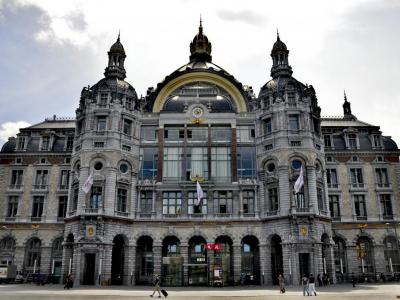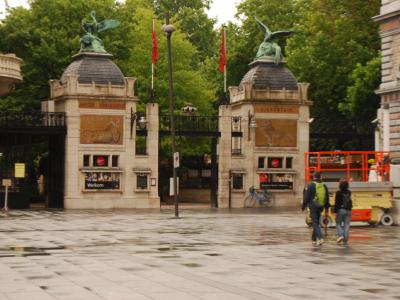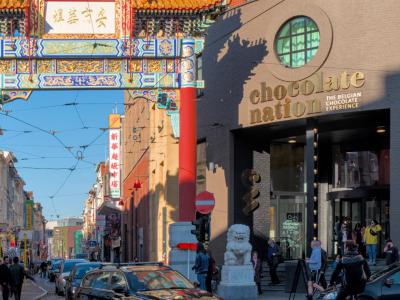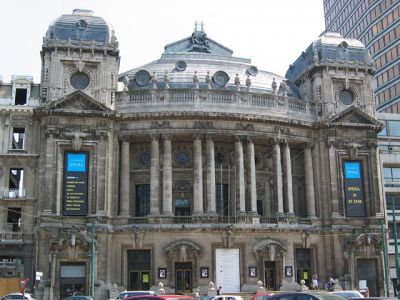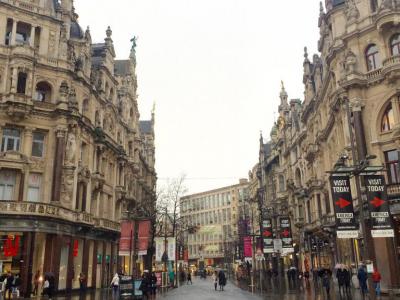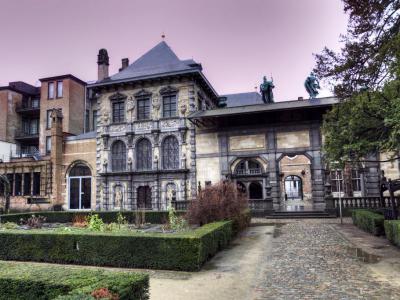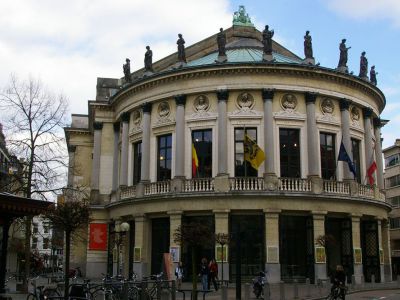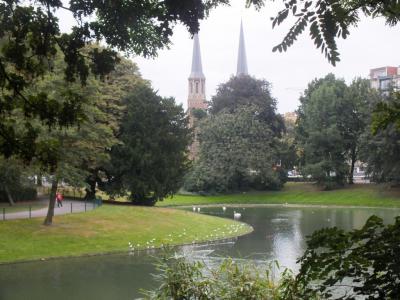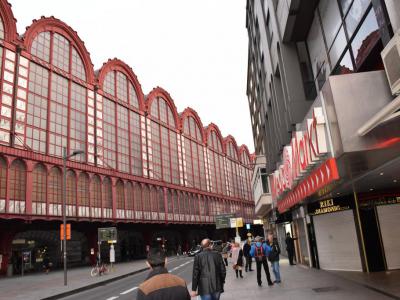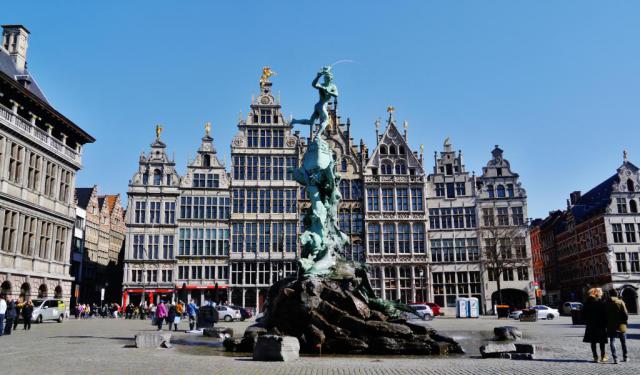Antwerp Historic Center Walk (Self Guided), Antwerp
Antwerp is a bustling metropolis, replete with modern entertainment, yet it is the centuries-old city center that fuels tourists' interest the most. Indeed, downtown Antwerp is steeped in history. So much so, in fact, that to see all that it has to offer, you'll need way more than one day.
Here history awaits you practically round every corner – seen in the ancient building-fronts on narrow streets, breathed on the banks of the Scheldt River, or tasted in the intimate pubs and restaurants abounding the area.
Still, if you have only one day in the city, here are several stop-off points to look out for on the charming cobbled streets of Antwerp:
Antwerpen-Centraal – the Antwerp Central Station, one of the city’s main landmarks and, according to American Newsweek magazine, the fourth most beautiful train station in the world.
Antwerp Zoo – one of the oldest (open since 1843) and best-known zoos in Europe, with 5,000 animals gathered on 10 hectares of land.
Chocolate Nation – the largest chocolate museum in the world, entirely devoted to Belgian chocolate.
Vlaamse Opera – aka the Kunsthuis, home to the Flemish Opera and the Royal Ballet of Flanders.
Meir Street – the most frequently visited shopping thoroughfare in Belgium; pre-eminent hotspot for every shopaholic.
Rubenshuis – the palatial house-museum of Peter Paul Rubens (1577-1640), brilliant and versatile artist, who spent here 25 years, producing most of his oeuvre.
Bourla Theater – the splendid theatrical temple, created by Pierre Bruno Bourla in the 19th century; top-class theater of international quality.
Stadspark – triangular City Park to respite in, away from the hustle and bustle of the shopping streets.
Diamond District – the home of jewelers and diamond merchants.
To explore these attractions more closely, take our self-guided walking tour and enjoy yourself!
Here history awaits you practically round every corner – seen in the ancient building-fronts on narrow streets, breathed on the banks of the Scheldt River, or tasted in the intimate pubs and restaurants abounding the area.
Still, if you have only one day in the city, here are several stop-off points to look out for on the charming cobbled streets of Antwerp:
Antwerpen-Centraal – the Antwerp Central Station, one of the city’s main landmarks and, according to American Newsweek magazine, the fourth most beautiful train station in the world.
Antwerp Zoo – one of the oldest (open since 1843) and best-known zoos in Europe, with 5,000 animals gathered on 10 hectares of land.
Chocolate Nation – the largest chocolate museum in the world, entirely devoted to Belgian chocolate.
Vlaamse Opera – aka the Kunsthuis, home to the Flemish Opera and the Royal Ballet of Flanders.
Meir Street – the most frequently visited shopping thoroughfare in Belgium; pre-eminent hotspot for every shopaholic.
Rubenshuis – the palatial house-museum of Peter Paul Rubens (1577-1640), brilliant and versatile artist, who spent here 25 years, producing most of his oeuvre.
Bourla Theater – the splendid theatrical temple, created by Pierre Bruno Bourla in the 19th century; top-class theater of international quality.
Stadspark – triangular City Park to respite in, away from the hustle and bustle of the shopping streets.
Diamond District – the home of jewelers and diamond merchants.
To explore these attractions more closely, take our self-guided walking tour and enjoy yourself!
How it works: Download the app "GPSmyCity: Walks in 1K+ Cities" from Apple App Store or Google Play Store to your mobile phone or tablet. The app turns your mobile device into a personal tour guide and its built-in GPS navigation functions guide you from one tour stop to next. The app works offline, so no data plan is needed when traveling abroad.
Antwerp Historic Center Walk Map
Guide Name: Antwerp Historic Center Walk
Guide Location: Belgium » Antwerp (See other walking tours in Antwerp)
Guide Type: Self-guided Walking Tour (Sightseeing)
# of Attractions: 9
Tour Duration: 2 Hour(s)
Travel Distance: 3.9 Km or 2.4 Miles
Author: mary
Sight(s) Featured in This Guide:
Guide Location: Belgium » Antwerp (See other walking tours in Antwerp)
Guide Type: Self-guided Walking Tour (Sightseeing)
# of Attractions: 9
Tour Duration: 2 Hour(s)
Travel Distance: 3.9 Km or 2.4 Miles
Author: mary
Sight(s) Featured in This Guide:
- Antwerpen-Centraal (Antwerp Central Station)
- Antwerp Zoo
- Chocolate Nation Museum
- Vlaamse Opera (Flemish Opera)
- Meir Shopping Street
- Rubenshuis (Rubens House)
- Bourla Theater
- Stadspark (City Park)
- Pelikaanstraat (Pelikan Street) and Diamond District
1) Antwerpen-Centraal (Antwerp Central Station) (must see)
Antwerp is a perfect blend of old and new, renowned for its great effort in preserving historic buildings. One such building is the Antwerp Central Station, aka Middenstatie (Middle station). The latter name – now an antiquated expression in Dutch – is seen on the plaque fixed on the north wall of the Station.
A key landmark in the city, this mighty edifice is one of the finest examples of railway architecture in Belgium. It's been repeatedly voted among the world’s most impressive railway stations, including number four in 2009 by the U.S. Newsweek magazine, and number one in 2014 by the British-American magazine Mashable.
The original stone-clad structure, with a steel platform covering, was designed by Louis Delacenserie. It was built between 1895 and 1905 as a replacement for the first terminus of the Brussels-Mechelen-Antwerp railway.
Because of its unique architecture, historians still struggle to attribute the Antwerpen-Centraal to any particular style. The eclectic mix features a Neo-Gothic front, a massive dome over the iron-glass waiting hall, for which the building has been colloquially referred to as the "spoorwegkathedraal" ("railroad cathedral"), and a modern multilevel platform system. Another notable element, the viaduct leading into the Station, was designed by local architect, Jan Van Asperen.
During WWII, the train hall sustained severe damage by V-2 rockets, which is still visible today due to a lasting wave-distortion in the roof.
Recently, the Station was completely renovated, and in 2007 had an underground tunnel opened. Today it operates 14 railways tracts at four different terminals and plays a vital role in connecting various parts of Belgium.
If you're an architecture buff or railway enthusiast, having the Antwerpen-Centraal on your list of things to see is a must! But even if you're neither of these, we still recommend visiting it, just for the spectacle.
A key landmark in the city, this mighty edifice is one of the finest examples of railway architecture in Belgium. It's been repeatedly voted among the world’s most impressive railway stations, including number four in 2009 by the U.S. Newsweek magazine, and number one in 2014 by the British-American magazine Mashable.
The original stone-clad structure, with a steel platform covering, was designed by Louis Delacenserie. It was built between 1895 and 1905 as a replacement for the first terminus of the Brussels-Mechelen-Antwerp railway.
Because of its unique architecture, historians still struggle to attribute the Antwerpen-Centraal to any particular style. The eclectic mix features a Neo-Gothic front, a massive dome over the iron-glass waiting hall, for which the building has been colloquially referred to as the "spoorwegkathedraal" ("railroad cathedral"), and a modern multilevel platform system. Another notable element, the viaduct leading into the Station, was designed by local architect, Jan Van Asperen.
During WWII, the train hall sustained severe damage by V-2 rockets, which is still visible today due to a lasting wave-distortion in the roof.
Recently, the Station was completely renovated, and in 2007 had an underground tunnel opened. Today it operates 14 railways tracts at four different terminals and plays a vital role in connecting various parts of Belgium.
If you're an architecture buff or railway enthusiast, having the Antwerpen-Centraal on your list of things to see is a must! But even if you're neither of these, we still recommend visiting it, just for the spectacle.
2) Antwerp Zoo (must see)
Established in 1843, the Antwerp Zoo is one of the oldest zoos in the world and is home to the Centre for Research and Conservation (CRC) along with the many animals and their various exhibits. Open all seven days of the week, the Zoo is located right next to Antwerp Centraal Railway Station at the Astrid Square.
The Zoo that started off in a small area of about 4 acres occupies over 26 acres of land today and is home to almost 950 different species of animals. From penguins to sea lions, from zebras to macaws and toucans and from commonly occurring apes to the near threatened okapis, the Zoo has them all. For some period, the Zoo also housed dolphins but the infrastructure demands could not be accommodated by a Zoo that was right in the center of the city.
From its inception, the Zoo has promoted wildlife preservation and through its recreational and educational exhibits pitches the importance of conservation to its 1.5 million visitors every year. The Zoo participates in the European Endangered Species Programme and has helped in the breeding of okapis, peafowls, tamarins and otters to name a few.
The Antwerp Zoo deserves at least half a day’s attention and once you are there, we are sure you will stay for more. But do not forget to pick up the schedule of the feeding times for these natural wonders at the entrance to see them interact with the Zoo staff.
The Zoo that started off in a small area of about 4 acres occupies over 26 acres of land today and is home to almost 950 different species of animals. From penguins to sea lions, from zebras to macaws and toucans and from commonly occurring apes to the near threatened okapis, the Zoo has them all. For some period, the Zoo also housed dolphins but the infrastructure demands could not be accommodated by a Zoo that was right in the center of the city.
From its inception, the Zoo has promoted wildlife preservation and through its recreational and educational exhibits pitches the importance of conservation to its 1.5 million visitors every year. The Zoo participates in the European Endangered Species Programme and has helped in the breeding of okapis, peafowls, tamarins and otters to name a few.
The Antwerp Zoo deserves at least half a day’s attention and once you are there, we are sure you will stay for more. But do not forget to pick up the schedule of the feeding times for these natural wonders at the entrance to see them interact with the Zoo staff.
3) Chocolate Nation Museum (must see)
The Chocolate Nation museum recounts the proud history of Belgian chocolate, from day one to the present. The innovative display – 14 themed rooms, 4,000 square meters of space – offers an extensive and informative journey, from the cocoa plantations in the equatorial jungle to the world's largest cocoa storage in the Port of Antwerp.
A giant, moving fantasy machine shows how Belgian chocolate is made and what inspires its worldwide adoration. The museum has ateliers, rooms for workshops, and its own Bean To Bar Laboratory where visitors can see chocolatiers at work or even partake in a workshop, learning to make chocolate themselves.
There are multiple sampling opportunities along the way, where you can taste many different kinds of chocolate to your heart's content – great fun for those with a sweet tooth! The museum also has its own restaurant, Octave, where you can enjoy typical Belgian dishes with a twist, combining classic flavors with contemporary influences.
A trip to Antwerp is not complete without a visit to Chocolate Nation – undoubtedly Belgium’s most delectable attraction! Especially not to be missed by chocolate lovers!
Why You Should Visit:
A unique insight into Belgian chocolate traditions and innovations; packed with experiences and tales of chocolate brands and chocolatiers.
Tip:
The ticket prices include an audio guide and various chocolate tastings.
A giant, moving fantasy machine shows how Belgian chocolate is made and what inspires its worldwide adoration. The museum has ateliers, rooms for workshops, and its own Bean To Bar Laboratory where visitors can see chocolatiers at work or even partake in a workshop, learning to make chocolate themselves.
There are multiple sampling opportunities along the way, where you can taste many different kinds of chocolate to your heart's content – great fun for those with a sweet tooth! The museum also has its own restaurant, Octave, where you can enjoy typical Belgian dishes with a twist, combining classic flavors with contemporary influences.
A trip to Antwerp is not complete without a visit to Chocolate Nation – undoubtedly Belgium’s most delectable attraction! Especially not to be missed by chocolate lovers!
Why You Should Visit:
A unique insight into Belgian chocolate traditions and innovations; packed with experiences and tales of chocolate brands and chocolatiers.
Tip:
The ticket prices include an audio guide and various chocolate tastings.
4) Vlaamse Opera (Flemish Opera)
The Vlaamse Opera is the Flemish Opera financed by the Flemish Government and the city councils of Antwerp and Ghent. Directed by Aviel Cahn, this single opera company performs in both, Antwerp as well as Ghent. The Opera is carrying forward the trend of one opera company performing in two historical theatres of the Flemish region set in 1981 by Opera voor Vlaanderen.
The history of opera in Antwerp dates back to 1661 when performances were held at the Grote Markt. The influence of the French artists in the performance troupes led to the adoption of French as the official language for all performances. A theatre was first constructed in 1709 and even enjoyed royal patronage between the years 1815 – 1829. However, it never garnered the attention it deserved and was never big enough to entertain a large crowd. It was only in 1834 that a new theatre was built to this effect and is used to this date for theatre performances. After many discussions, work for renovation of the theatre was finally taken up in 2005 at a budget of 24 million euros. The seating in the main auditorium, office spaces for the theatre and a new heating system were put in place. Much of the renovation work still remains but the Vlaamse Opera’s contemporary performances are being conducted in the renovated building since 2007. The Opera never ceases to amaze its audience whether they are in Ghent or in Antwerp or whether they are performing a classic or something altogether anew.
The history of opera in Antwerp dates back to 1661 when performances were held at the Grote Markt. The influence of the French artists in the performance troupes led to the adoption of French as the official language for all performances. A theatre was first constructed in 1709 and even enjoyed royal patronage between the years 1815 – 1829. However, it never garnered the attention it deserved and was never big enough to entertain a large crowd. It was only in 1834 that a new theatre was built to this effect and is used to this date for theatre performances. After many discussions, work for renovation of the theatre was finally taken up in 2005 at a budget of 24 million euros. The seating in the main auditorium, office spaces for the theatre and a new heating system were put in place. Much of the renovation work still remains but the Vlaamse Opera’s contemporary performances are being conducted in the renovated building since 2007. The Opera never ceases to amaze its audience whether they are in Ghent or in Antwerp or whether they are performing a classic or something altogether anew.
5) Meir Shopping Street (must see)
Meir is a famous shopping destination for the city of Antwerp and, along with the New Street in Brussels, one of the most important shopping areas in Belgium. The Meir shopping district encompasses the streets surrounding Our Lady’s Cathedral all the way to the Central Station. Once used to store wet wood for furniture, the area has come a long way to be recognized as one of the prime areas for shopping in the country. Once being a small street on the outskirts of the city, today Meir is an integral part of the city center.
With the opening of the Stadsfeestzaal Shopping Centre in 2007, the Meir has become the most expensive shopping destination in the economic union of Benelux. The area is home to all major shopping brands and attracts over 200,000 visitors from neighboring states and other European countries.
Along with being a shopping capital, the Meir has also seen the richness of architecture and the lavishness of the rich. It is home to some exquisite buildings such as ‘Osterrieth House’ at number 85 and the Royal Residence of the Belgian Kings, both built in the old Rococo style by architect Van Baurscheit. Whether for a shopping experience or just visiting to catch a glimpse of the past, Meir is a place that all must visit.
With the opening of the Stadsfeestzaal Shopping Centre in 2007, the Meir has become the most expensive shopping destination in the economic union of Benelux. The area is home to all major shopping brands and attracts over 200,000 visitors from neighboring states and other European countries.
Along with being a shopping capital, the Meir has also seen the richness of architecture and the lavishness of the rich. It is home to some exquisite buildings such as ‘Osterrieth House’ at number 85 and the Royal Residence of the Belgian Kings, both built in the old Rococo style by architect Van Baurscheit. Whether for a shopping experience or just visiting to catch a glimpse of the past, Meir is a place that all must visit.
6) Rubenshuis (Rubens House) (must see)
Known for his Counter Reformation portraits, landscapes and paintings, Sir Peter Paul Rubens was a Baroque painter, book illustrator and a diplomat during the early 1600s. The Rubens House is a city of Antwerp-owned and curated building that Rubens designed himself and spent most of his lifetime in.
Located on Wapper Street, Rubens purchased this house in 1610 and added a gallery, porch and a large studio in Greco-Roman classic styles and a hint of Italian Renaissance to the structure. Within the walls of this house, Rubens and his students, such as Anthony Van Dyck and Jacob Jordaens, created most of their works. Rubens’ work is categorized by various stages of productivity of his own life. However, all of Rubens’ work that is on display in the House today came back only after great efforts were put in by the people of Antwerp once it was decided to make the building into a monument in 1937.
The Rubens House is home to paintings such as Saint Claire of Assisi, The Annunciation and Adam and Eve made by the great painter himself in addition to the works of other contemporaries of his time. The House also displays various objects of art from the 17th century giving visitor a peek at the lavish lifestyles of those times. The Renaissance Garden which was renovated in 1993 takes inspiration from Rubens’ paintings and should not be missed.
Located on Wapper Street, Rubens purchased this house in 1610 and added a gallery, porch and a large studio in Greco-Roman classic styles and a hint of Italian Renaissance to the structure. Within the walls of this house, Rubens and his students, such as Anthony Van Dyck and Jacob Jordaens, created most of their works. Rubens’ work is categorized by various stages of productivity of his own life. However, all of Rubens’ work that is on display in the House today came back only after great efforts were put in by the people of Antwerp once it was decided to make the building into a monument in 1937.
The Rubens House is home to paintings such as Saint Claire of Assisi, The Annunciation and Adam and Eve made by the great painter himself in addition to the works of other contemporaries of his time. The House also displays various objects of art from the 17th century giving visitor a peek at the lavish lifestyles of those times. The Renaissance Garden which was renovated in 1993 takes inspiration from Rubens’ paintings and should not be missed.
7) Bourla Theater
Whether you are a theatre buff or not, you are sure to get captivated and enthralled by this enchanting little theatre in Antwerp. Standing tall, boasting a neat Neo-Classic style of architecture, the Bourla Theatre is a must visit in Antwerp.
Although there are bigger names that beat Bourla in terms of magnitude and status, they all lack the charm, brilliant design and sheer grandeur that the Bourla Theatre proudly showcases. Atop this magnificent structure are the noted figures of theatre right from Shakespeare and Mozart to Aeschylus and Gluck.
Built in 1827, the Bourla Theatre was designed by Pierre Bruno Bourla, a French architect who served the city of Antwerp since 1819. At a time when Europe was going through a Golden Era in theatre and performing arts, the only theatre that Antwerp possessed was the Tapissiers House, once a market for tapestry. When the rest of Europe boasted grand world class theatres, the main theatre of Antwerp lacked style and modern amenities. It was during the Dutch occupation when the Pierre Bruno Bourla was commanded to come up with innovative and revolutionary designs for a new opera house and theatre. The result of his hard work is the Theater that stands to this day.
Apart from its rich history, the Bourla Theatre is well known for its magnificent design and opulent interiors. And if you want to really get a feel of this majestic building without sitting through a play, you can stop for brunch at a restaurant in the foyer of the building.
Although there are bigger names that beat Bourla in terms of magnitude and status, they all lack the charm, brilliant design and sheer grandeur that the Bourla Theatre proudly showcases. Atop this magnificent structure are the noted figures of theatre right from Shakespeare and Mozart to Aeschylus and Gluck.
Built in 1827, the Bourla Theatre was designed by Pierre Bruno Bourla, a French architect who served the city of Antwerp since 1819. At a time when Europe was going through a Golden Era in theatre and performing arts, the only theatre that Antwerp possessed was the Tapissiers House, once a market for tapestry. When the rest of Europe boasted grand world class theatres, the main theatre of Antwerp lacked style and modern amenities. It was during the Dutch occupation when the Pierre Bruno Bourla was commanded to come up with innovative and revolutionary designs for a new opera house and theatre. The result of his hard work is the Theater that stands to this day.
Apart from its rich history, the Bourla Theatre is well known for its magnificent design and opulent interiors. And if you want to really get a feel of this majestic building without sitting through a play, you can stop for brunch at a restaurant in the foyer of the building.
8) Stadspark (City Park)
The Stadspark is an English styled park laid out over 35 acres of land not very far from Antwerp Centraal Station. This triangular park located between Rubenslei, Van Eycklei and Quinten Matsijslei is the only park located in the city center of Antwerp. Constructed in the late 1860s by architect E. Van Cuyck, the Park is a conversion of an old Spanish fortification.
A pond in the Park adds to the scenery while also playing host to some common water birds. A white pedestrian bridge was constructed over the pond which makes it even more picturesque. Various statues decorate the Park along with war memorials. A World War II bunker has remained a part of the Park since it was created. Today, the Park is a destination for joggers, rollerbladers and elderly walkers. You can often see rabbits around the Park who are more than willing to jog (or hop) along with you. However, the Park is too centrally located and cannot manage to take you completely away from the traffic noises arising from the city.
The Park is filled with different kinds of trees, some of which are not even native to the land. Open all times of the day, you can visit the park anytime you prefer although a day light visit is recommended. Once here, you can always go back to shopping areas which are located just outside the Park.
A pond in the Park adds to the scenery while also playing host to some common water birds. A white pedestrian bridge was constructed over the pond which makes it even more picturesque. Various statues decorate the Park along with war memorials. A World War II bunker has remained a part of the Park since it was created. Today, the Park is a destination for joggers, rollerbladers and elderly walkers. You can often see rabbits around the Park who are more than willing to jog (or hop) along with you. However, the Park is too centrally located and cannot manage to take you completely away from the traffic noises arising from the city.
The Park is filled with different kinds of trees, some of which are not even native to the land. Open all times of the day, you can visit the park anytime you prefer although a day light visit is recommended. Once here, you can always go back to shopping areas which are located just outside the Park.
9) Pelikaanstraat (Pelikan Street) and Diamond District
The Pelikan Street (Pelikaanstraat) and the Diamond District in Antwerp, serve as the heart of the global diamond trade, a distinction that dates back to the second half of the 19th century. This area is not only critical for its economic contributions but also stands out for its architectural beauty, showcasing picturesque buildings in Art Nouveau and eclectic styles.
Antwerp’s association with diamonds dates back to the 15th century and was revolutionized in the later years by Lodewyk van Berken's invention of the scaif-a diamond polishing tool. This innovation enabled the creation of the sparkling, multifaceted diamonds that became synonymous with European nobility, enhancing Antwerp's status in the diamond world. Notably, Charles the Bold commissioned van Berken to cut and polish the famed Florentine Diamond.
By the 1890s, a robust diamond industry had been established in Antwerp by families of diamond traders and manufacturers, many of whom migrated from Amsterdam. This industry thrived and evolved into what is now known as the Diamond Quarter or Diamantkwartier, also dubbed the Square Mile. This area encompasses several square blocks around the central station and is a short walk from Meir, Antwerp’s principal shopping street.
Historically, the district processed a significant portion of the world's diamonds, with about 84% of all rough diamonds passing through as of 2012, despite much of the cutting and polishing work having moved to lower-wage centers globally. Remarkably, around 50% of rough diamonds return to Antwerp for processing, evidencing its continued importance in the global diamond trade, which sees a turnover of approximately 54 billion dollars.
The Diamond District is notably multicultural, with a diverse population of Jewish, Jain Indians, Maronite Christian Lebanese, and Armenian dealers, known collectively as diamantaires. More than 80% of Antwerp's Jewish community is employed in this trade, and historically, Yiddish was the primary language of the diamond exchanges. Business activities in the district pause on Saturdays, respecting the Jewish Sabbath.
In addition to its economic and cultural significance, the district is also a vibrant area filled with a variety of restaurants, bars, and cafes, catering to the diverse crowd that the diamond trade attracts. This makes the Diamond District not only a global hub for diamond trading but also a lively community and tourist attraction.
Antwerp’s association with diamonds dates back to the 15th century and was revolutionized in the later years by Lodewyk van Berken's invention of the scaif-a diamond polishing tool. This innovation enabled the creation of the sparkling, multifaceted diamonds that became synonymous with European nobility, enhancing Antwerp's status in the diamond world. Notably, Charles the Bold commissioned van Berken to cut and polish the famed Florentine Diamond.
By the 1890s, a robust diamond industry had been established in Antwerp by families of diamond traders and manufacturers, many of whom migrated from Amsterdam. This industry thrived and evolved into what is now known as the Diamond Quarter or Diamantkwartier, also dubbed the Square Mile. This area encompasses several square blocks around the central station and is a short walk from Meir, Antwerp’s principal shopping street.
Historically, the district processed a significant portion of the world's diamonds, with about 84% of all rough diamonds passing through as of 2012, despite much of the cutting and polishing work having moved to lower-wage centers globally. Remarkably, around 50% of rough diamonds return to Antwerp for processing, evidencing its continued importance in the global diamond trade, which sees a turnover of approximately 54 billion dollars.
The Diamond District is notably multicultural, with a diverse population of Jewish, Jain Indians, Maronite Christian Lebanese, and Armenian dealers, known collectively as diamantaires. More than 80% of Antwerp's Jewish community is employed in this trade, and historically, Yiddish was the primary language of the diamond exchanges. Business activities in the district pause on Saturdays, respecting the Jewish Sabbath.
In addition to its economic and cultural significance, the district is also a vibrant area filled with a variety of restaurants, bars, and cafes, catering to the diverse crowd that the diamond trade attracts. This makes the Diamond District not only a global hub for diamond trading but also a lively community and tourist attraction.
Walking Tours in Antwerp, Belgium
Create Your Own Walk in Antwerp
Creating your own self-guided walk in Antwerp is easy and fun. Choose the city attractions that you want to see and a walk route map will be created just for you. You can even set your hotel as the start point of the walk.
Antwerp's Historical Churches Tour
Antwerp, a city steeped in history and culture, boasts an array of historical churches that stand as testaments to its past.
Reigning supreme among them is the Cathedral of Our Lady, a stunning 14th-century Gothic masterpiece. Its towering spire dominates the city skyline and houses invaluable artworks by renowned artists such as Peter Paul Rubens, Otto van Veen, Jacob de Backer, and Marten de... view more
Tour Duration: 2 Hour(s)
Travel Distance: 3.6 Km or 2.2 Miles
Reigning supreme among them is the Cathedral of Our Lady, a stunning 14th-century Gothic masterpiece. Its towering spire dominates the city skyline and houses invaluable artworks by renowned artists such as Peter Paul Rubens, Otto van Veen, Jacob de Backer, and Marten de... view more
Tour Duration: 2 Hour(s)
Travel Distance: 3.6 Km or 2.2 Miles
Antwerp Introduction Walking Tour
A major city-port on the River Scheldt in Belgium, Antwerp is known primarily as the diamond capital of Europe. For centuries, Antwerp's Diamond District has been the center of diamond trade, with thousands of dealers, cutters and polishers processing 85% of the world's rough diamonds each year.
Historical Antwerp has its origins in a Gallo-Roman settlement, first mentioned in the 4th... view more
Tour Duration: 2 Hour(s)
Travel Distance: 3.5 Km or 2.2 Miles
Historical Antwerp has its origins in a Gallo-Roman settlement, first mentioned in the 4th... view more
Tour Duration: 2 Hour(s)
Travel Distance: 3.5 Km or 2.2 Miles
The Most Popular Cities
/ view all



